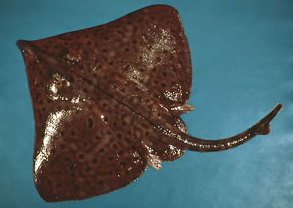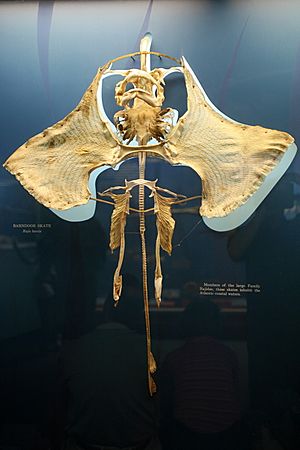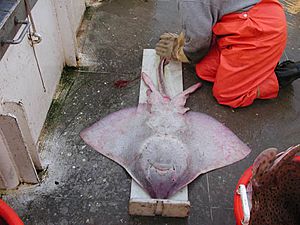Barndoor skate facts for kids
Quick facts for kids Barndoor skate |
|
|---|---|
 |
|
| Barndoor skate, Dipturus laevis | |
| Conservation status | |
| Scientific classification |
The barndoor skate (Dipturus laevis) is a type of skate, which is a flat fish with a skeleton made of cartilage. It lives in the ocean and is found in the northwestern Atlantic Ocean. You can find it from the Grand Banks of Newfoundland down to North Carolina.
This skate is one of the biggest skates in the North Atlantic. It can grow up to 1.5 m (5 ft) long. The barndoor skate is a carnivore, meaning it eats other animals. It mainly feeds on small creatures without backbones (like crabs) and other fish that live near the sea floor.
Sadly, the number of barndoor skates dropped a lot in the 1960s and early 1970s. This happened because of too much fishing. In 2003, a group called the World Conservation Union said it was an endangered species. But good news! The number of barndoor skates has grown a lot since 1990. By 2012, there were even more skates than in the 1960s. Because of this, in 2019, the skate's status was changed to "least concern" by the IUCN. This means it's not as much at risk anymore. Most of the time, fishing boats don't try to catch barndoor skates on purpose. They usually get caught by accident in nets meant for other fish.
Contents
What does the barndoor skate look like?
The barndoor skate has a flat body that looks like a disk. It has sharp corners and a pointy nose. Its pectoral fins are wide and flat, like wings. These fins help the skate move through the water.
Just like sharks, the barndoor skate does not have bones. Instead, its skeleton is made of cartilage. Cartilage is a strong, bendy material. The skate also has special openings called gill slits under its body. These openings let water flow over its gills, helping it breathe.
The skate has two dorsal fins that are close together and far back on its tail. Its two eyes are on the top of its body. The top of the skate is usually brown or reddish-brown with darker spots. The bottom is lighter, from white to gray, with gray spots.
The barndoor skate is one of the largest skates in the North Atlantic. It can be up to 1.5 m (5 ft) long and weigh up to 18 kg (40 lb). Some people have even reported seeing skates up to 1.8 meters (6 ft) long!
Its tail is not very long and usually doesn't have sharp, thorn-like bumps called dermal denticles. This is how it's different from most other skates. However, bigger skates might have three rows of smaller denticles on their tails. Older female skates can also have denticles on their heads and shoulders.
Where do barndoor skates live?
Barndoor skates live in the ocean from the banks of Newfoundland and the southern Gulf of St. Lawrence down to North Carolina. They can be found on different types of ocean bottoms, like soft mud, sand, or rocks.
These skates live in both shallow water near the shoreline and deep water up to 750 m (2,460 ft). However, they are most often found in water less than 150 m (500 ft) deep. They can live in very cold water, just above freezing, up to 20 °C (68 °F).
It seems that barndoor skates move closer to the shore in the autumn. Then, they move further out to sea when the weather gets warmer. They can live in brackish water, which is a mix of fresh and salt water. But they prefer water that is saltier. Scientists believe they do not travel long distances from north to south.
What do barndoor skates eat?
The barndoor skate is a carnivorous fish. This means it eats other animals. Its main food includes creatures that live on the sea floor, like polychaete worms, snails, clams, and different kinds of crabs. They also eat lobsters, shrimps, and squids.
Many types of fish are also on their menu. These include spiny dogfish, alewife, Atlantic herring, hakes, and various flounders. Young barndoor skates mostly eat smaller creatures like tiny worms, small crustaceans, and shrimp.
Sometimes, the denticles (small bumps) on a skate's snout are worn smooth. This suggests that they use their snouts to dig in the mud or sand to find clams and other buried food.
Why are barndoor skates important to humans?
The barndoor skate is one of five types of skates in the Gulf of Maine that are caught by fishers. However, other skates like the winter skate and the thorny skate are caught more often.
Barndoor skates are usually caught by accident. This happens when large fishing boats use big nets to catch other types of fish. When they are caught, their flesh can be used as bait for other fishing, or made into fish meal and pet food. The meat from their "wings" (pectoral fins) is also sold for people to eat.
Since 1981, more skates have been caught. This is partly because there's more demand for them as lobster bait. Also, more countries want to buy skate wings. In the United States, it was against the law to sell barndoor skates from 2003 to 2018.
How are barndoor skates protected?
The number of barndoor skates dropped very quickly in the 1960s and early 1970s. This was when many foreign fishing boats were catching a lot of fish. The population stayed very low until about 1990. But then, the numbers started to grow very fast. By 2005, they were almost back to the levels seen in the 1960s. In fact, by 2012, there were even more skates than in the 1960s!
In 1998, a study said that the barndoor skate was almost gone. But this study only used data up to 1993, so it didn't show the recovery that had already started. In 1999, two groups asked the National Marine Fisheries Service (NMFS) to list the barndoor skate as an endangered species.
However, after studying the situation, the NMFS decided in 2002 that the species did not need to be listed as endangered. They saw that the number of skates had increased quickly since 1993. In 1994, the World Conservation Union had listed the barndoor skate as "vulnerable." But in 2003, they changed it to "endangered" on the IUCN Red List. Then, in 2019, because the population had grown so much, the species was changed to "least concern."
Every year, the National Oceanic and Atmospheric Administration (NOAA) checks on different ocean species. They release a report about how well efforts are working to protect fish. If a species is being overfished, groups have to make a plan to fix the problem. In 2006, NOAA announced that because of conservation efforts, the number of barndoor skates had grown enough that they were no longer considered "overfished."
Naming the barndoor skate
The barndoor skate was first described in 1818 by a scientist named Samuel Latham Mitchill. He called it Raja laevis. Later, its scientific name was changed to Dipturus laevis, which is what it's called today.
The name Dipturus comes from two Greek words: di, meaning "two," and pteryx, meaning "wing." The original genus name, Raja, is still used as a group name for some skates.
See also
 In Spanish: Dipturus laevis para niños
In Spanish: Dipturus laevis para niños




